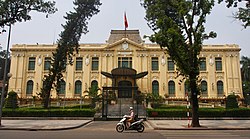State Guest House (Vietnam)
 From Wikipedia the free encyclopedia
From Wikipedia the free encyclopedia
| State Guest House | |
|---|---|
| Native name Vietnamese: Nhà khách Chính phủ | |
 Tonkin Palace functions as Vietnam's State Guesthouse today | |
| Location | 12 Ngô Quyền street, Tràng Tiền, Hoàn Kiếm District, Hanoi, Vietnam |
| Area | 15,000 m2 (160,000 sq ft) (floor space) 117,000 m2 (1,260,000 sq ft) (site) |
| Built for | French Governor of Tonkin |
| Architect | Auguste Henri Vildieu |
| Architectural style(s) | French Colonial |
| Website | Government Guesthouse |
The State Guest House (Vietnamese: Nhà khách Chính phủ) is a historical monument in Hoàn Kiếm District, Hanoi, Vietnam. It is presently used as a state guest house.
The building is representative of French Colonial architecture in French Indochina. It formerly was the Residential palace of the Tonkin Governor (French: Le Palais du Résident Supérieur du Tonkin, Vietnamese: Dinh Thống Sứ Bắc Kỳ), built between 1918 and 1919 to house the French Governor of Tonkin. It was later renamed the Tonkin Palace (Vietnamese: Bắc Bộ Phủ) when the Viet Minh took over northern Vietnam.
History[edit]

The palace was built by Auguste Henri Vildieu between 1918 and 1919 to house the French Governor of Tonkin.
The building was the location of Viet Minh's takeover of northern Vietnam, following the August Revolution in 1945.[1]
On December 20, 1946, the French Army battled to capture Tonkin Palace from Viet Minh. The fighting was intense and marked the early stage of the Indochina War. After six attacks, 122 casualties, and the destruction of four tanks, the French Army occupied the palace.
After the partition of Vietnam, it became the state guest house of North Vietnam, while South Vietnam had the state guest house at Nguyễn Du Street, Nhà khách 108 Nguyễn Du, and close to the Independence Palace.
In modern times, the building serves as the State Guest House of the Vietnamese Government.
Gallery[edit]
- Tonkin Palace at night
See also[edit]
- Presidential Palace in Ba Đình District, built between 1900 and 1906 to house the French Governor-General of Indochina
References[edit]
Notes


